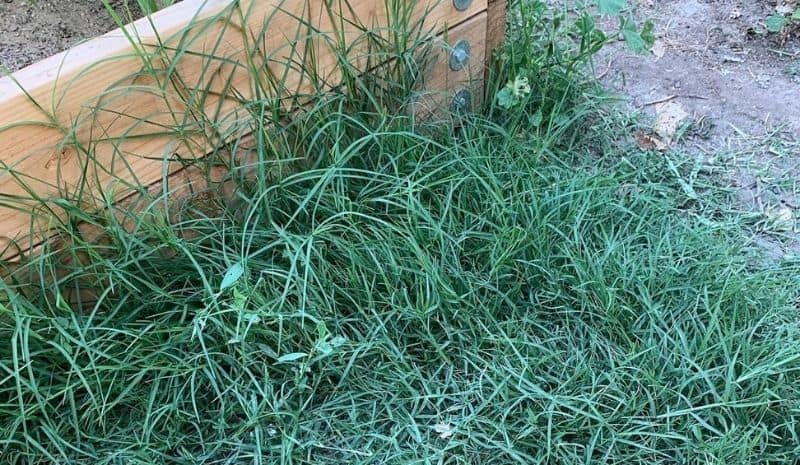Bermuda grass, also called the dog’s tooth grass, is an invasive turfgrass that can take over your lawn and flowerbeds in no time. It spreads fast and infiltrates other grass types such as fescue, zoysia, and St. Augustine.
Herbicides that work on this grass are also toxic to other kinds of lawn grass, so it is quite tricky to get rid of it. Even weeding it out from flower beds is difficult because of the long roots. Let’s look at how to kill Bermuda grass and not hurt other plants.
Guide on Getting Rid of Bermuda Grass
- Keep your lawn healthy and well-watered;
- In summer, try using mulching and solarization as they are the most effective solutions;
- Use organic and chemical herbicides to kill the plant for good.

Is Bermuda grass a weed?
This grass is used as a regular turfgrass on lawns and golf courses. However, it’s also an extremely invasive weed that infiltrates lawns and flowerbeds and affects other beneficial types of turfgrass.
The plant is native to Africa and is incredibly resilient to hot weather, which is why it’s widely used in the south of the USA. It can handle the heat, drought, damage from stepping on it, and other things.
When it starts invading the spaces where other types of grass are planted, it begins to push them out. Many people have problems with Bermuda grass in fescue, and its resilience makes it very hard to eliminate.
What parts does Bermuda grass have?
This plant has a system of roots called rhizomes, which grow not like a typical web of roots but can create new plants. Aboveground parts (stolons) are the stems that also shoot offspring, making this grass very spreadable. If you pluck only the aboveground parts, the plant will multiply beneath the ground surface, and so on.
This is why it’s so difficult to get rid of it: most of the treatments only hurt the stolons and the leaves, leaving rhizomes fully intact, and regrowth inevitably happens.
Why is it difficult to kill Bermuda grass?
The plant has an extensive root system, which goes deep into the soil and reproduces by creating underground shoots from rhizomes. It uses above-ground stolons and seeds to reproduce further, so when all the conditions are favorable, it grows extremely fast. Thus you will see new grass unless you kill every part of it.
Bermuda grass control and management
Managing this grass is a year-long occupation. To stop Bermuda grass from spreading, you need to keep your lawn healthy. From January to April, you need to mow it lower than usual before it starts greening in spring and fertilize it well afterward.
These measures will promote growth. You can also maintain the turf healthy by keeping it irrigated. Mulching and solarization are the best ways to prevent Bermuda grass in flower beds and your lawn.
Using mulch stops the grass growth, and it also acts as a fertilizer once the material starts to decompose in the soil. Use standard landscape fabric and place it over the areas where it grows. This won’t let new grass spring from the ground, and solarisation and foot impact will eventually suppress it and clear this patch.
Clear plastic mulching or solarization can help to remove the dog’s tooth grass from the places where no other plants grow. Use clear plastic to cover the plant and leave it in the sun for about two months in the summer. If the area is well-lit, the plant will be burnt under the plastic without causing damage to the surrounding area. Mulching and solarization are good ways to control the grass.

How to kill Bermuda grass step by step
Here is a comprehensive guide on how to kill the dog’s tooth grass for good.
Step 1 Don’t mow your lawn too short
Mow your lawn higher and try to keep it more than 3 inches. This will contribute to a healthier lawn. Mowing won’t damage the weed, but it will limit the amount of sun Bermuda grass gets.
Step 2 Use killing agents
You need a herbicide that will fully get rid of the grass. The majority of them only affect the leaves and don’t hurt underground rhizomes. That’s the reason it can resurface later, even after using herbicides. Apply a systemic herbicide that will affect the plant above and beneath the ground.
Step 3 Treating around ornamentals
If you want to remove the grass from your flower beds, you need to be careful. Most herbicides are non-selective, so they can kill or damage other plants. You should check what ornamental plants can be damaged on the product packaging.
How to kill the dog’s tooth grass naturally?
If you want to try organic methods, here are the most effective ones.
Vinegar
You can try killing Bermuda grass with vinegar, which is an effective and simple treatment. Use a 10% solution and spray it on the grass. It’s incredibly potent, so it will affect both stolons and underground rhizomes. It’s easy to get rid of the weed with vinegar, but keep in mind that it can non-selectively kill other plants. You need to be as precise as possible during the application, so use a spray bottle, and apply it only when you isolate patches of Bermuda grass.
Weeding
Another way to eliminate Bermuda grass is to get rid of it manually. It will only work if the weed covers a small area. However, if you pull it after the rain when the soil is soft, it shouldn’t be a problem.
How to kill the dog’s tooth grass with herbicides?
If you want to apply a ready product, consider the two groups of herbicides listed below. They can help you cope with the weed on your territory.
Selective herbicides
You can use grass-selective herbicides with ingredients like sethoxydim and fluazifop. They effectively get rid of the grass if you apply them in early spring when the grass is short and after it grows back, but not higher than 6 inches.
Grass-selective herbicides are not always successful in killing the top part of the plant (stolon) and the underground part (rhizomes). They tackle only the visible part, and grass can still multiply below the ground and cause regrowth. Thus you will need to constantly cope with the weed to completely get rid of it.
Systemic herbicides
Will Roundup kill Bermuda grass? Glyphosate or Roundup is a non-selective herbicide that systematically kills any plant it’s applied to, including the dog’s tooth grass. This can be an effective solution if you don’t have any time or resources to eradicate Bermuda grass manually or organically, or if the infestation is severe.
It is the most effective solution for the weed on your lawn and flowerbeds since the actively growing weed stores the nutrients in the roots. Do the procedure in summer, not after drought, and don’t mow the grass 2-3 weeks before treatment.
Lawn care after you remove Bermuda grass

Here’s what you need to do to keep your lawn healthy and prevent Bermuda grass from appearing on your lawn and flower beds:
- Fertilize the lawn frequently. If your lawn is healthy, other weeds will find it difficult to infest it.
- Mow your lawn high. Mowing grass too short can injure the lawn scalp and leave vulnerable patches where weeds such as the dog’s tooth grass can grow. An optimal height is about 3 inches.
- Water it regularly. Ensure your lawn is well-watered and has a deep irrigation system in place.
FAQ About How to Kill Bermuda Grass
If you still have questions about Bermuda grass elimination, read the following section. Here I provide answers to the most common queries.
How do I permanently kill Bermuda grass?
If you use herbicides systematically, you will get rid of the weed on your lawn. Apply them locally so that they kill every part of Bermuda grass: its leaves, stolons, and roots.
What is the best product to kill Bermuda grass?
Use grass-selective herbicides with sethoxydim and fluazifop on the ingredients list in early spring. For young Bermuda grass below 6 inches high, use products that contain sethoxydim, clethodim, or fluazifop. Systemic treatments like Roundup work more aggressively.
How do you kill Bermuda grass naturally?
The best natural ways to kill it are mulching and solarizing. Covering the already grown plants with black plastic, along with mowing and irrigating your lawn, can help you get rid of the dog’s tooth grass in summer. You can also use clear plastic on sunny areas of your land: solarization burns out the weed without damaging the surrounding lawn.
Best Way to Get Rid of Bermuda Grass
Since Bermuda grass is so tricky to get rid of, preventing it from infesting your lawn and flowerbeds is preferable. Use mulching and solarization, keep your lawn thick and healthy, and prevent the weed from taking over your lawngrasses.
You can also apply grass-selective herbicides and systemic products to damage the stolon and rhizomes of the grass and eventually kill it. Sometimes several treatments are required to get it out fully. Which products have you used against Bermuda grass on your lawn? Write about your experience with Bermuda grass in the comments below!

